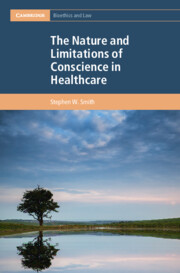
- Publisher:
- Cambridge University Press
- Online publication date:
- September 2025
- Print publication year:
- 2025
- Online ISBN:
- 9781108785006

The role of conscience in healthcare decision-making is explored in this important intervention in the fields of Health Law and Ethics, Medicine, Nursing and Philosophy. It takes a broad approach to conscience, looking beyond the standard examples of conscientious objection to argue that conscience permeates healthcare decisions. However, it also shows that not all decisions of conscience are worthy of legal or societal protection and that these are interests to be weighed rather than rights. Instead, conscience should be protected only when the individual exercising conscience abides by specific responsibilities. Additionally, the book explores the important issues of complicity with healthcare decisions and institutional or organisational conscience and argues they play an oversized role in general discussions of conscience. It further claims that we ought to pay much more attention to conscientious provision. The book concludes by looking at ways to more effectively regulate claims of conscience.
 Loading metrics...
Loading metrics...
* Views captured on Cambridge Core between #date#. This data will be updated every 24 hours.
Usage data cannot currently be displayed.
The PDF of this book complies with version 2.2 of the Web Content Accessibility Guidelines (WCAG), offering more comprehensive accessibility measures for a broad range of users and attains the highest (AAA) level of WCAG compliance, optimising the user experience by meeting the most extensive accessibility guidelines.
Allows you to navigate directly to chapters, sections, or non‐text items through a linked table of contents, reducing the need for extensive scrolling.
Provides an interactive index, letting you go straight to where a term or subject appears in the text without manual searching.
You will encounter all content (including footnotes, captions, etc.) in a clear, sequential flow, making it easier to follow with assistive tools like screen readers.
You will still understand key ideas or prompts without relying solely on colour, which is especially helpful if you have colour vision deficiencies.
You benefit from high‐contrast text, which improves legibility if you have low vision or if you are reading in less‐than‐ideal lighting conditions.